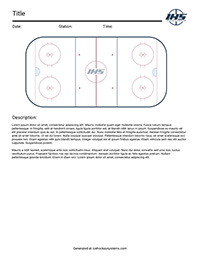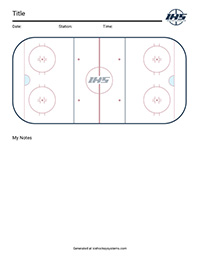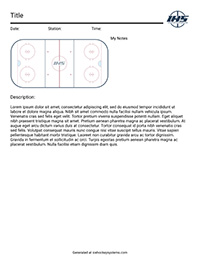Defensive Zone Coverage - Protect the House
Defensive Zone Coverage - Protect the House

Hi. This is Denis Savard of Ice Hockey Systems. Welcome. First of all we are talking about the D-Zone coverage here. One of the key things that’s going to be important for D-Zone coverage is about protecting the house. As you saw up here, I put a little design here where it looks a bit like a house. My artwork is not the best thing in the world but this is what it looks like. So it’s very, very important that we protect this area, and that’s why how we position our guys or whenever D1 and your puck here, F1 is supporting, and whenever D2 -- you follow that. We’re going to have our F2 in this area. We’re going to have our F3 down in the slide area.
This should be our positioning once we get in our zone, wherever, you should be in position. Now, depending on what the other teams are doing, one of the key things that you’re going to see is what their X1, their X2, obviously their X3 would position themselves on top here and be the shooter. You have their D1 and their D2 in this position here.
So right now as we speak, we got pretty much everything covered. If X1 has the puck, obviously we want our defenseman to be on the puck, to be on the opponent on their X1. The quicker the better. And the whole key about this as a defenseman, when you go out and check somebody, you want to make sure that you stick on the puck. You want to disrupt a separation from the puck and their player so your F1 would be able to come in and help and move the puck up maybe to F2 or however, just get it out so we’re on offense. The quicker we are or better defensively, the better we’re going to be on offense.
Now, situations are going to happen where the puck is going to be moved to X2. Pretty simple. There’s a rotation that has to be made now. They will have a D1 that was on this guy here. Now, F1 is on X2 because the puck has been moved. Key situation where D1 is to get back in this position here protecting their net.
Now, the one thin g that we’re going to be talking about too a lot of times is their X3 which is shooter, we want to make sure that our D2 comes out and locates their X3. We know that there is help here with our F2 in case he falls down or any circumstances that could happen. But obviously, D2, your job is to come out and locate X3, denying him to get a shot if that’s the case here and try to move the puck to X3.
Now, a lot of times you see a lot of forwards on D-Zone coverage are going to end up starting to creep up towards the boards when the puck is in the area here. The reason why we don’t want you to keep up along the boards, if I take you up here as an example, you would see how much time and space there is in this area here. And again, we want to protect the house. The house is there for a reason so that’s why we need you in this position here. If the puck is moved to the plank, obviously you want to get in the shooting lane and get out of the defenseman which is an easy task for you to do. And that’s pretty much your responsibility as F2 on the strong side.
F3, if there’s a breakdown down in this area here, that’s why you’re the support guy. You come down and help. And if there -- happened that somebody had fell down, you’re going to help us out in that situation here. At the same time, if they activate your D2, you will be going with it with your D2. That’s your guy all the way through. No matter what he does, you need to cover him to your way to the net.
Now, we talked about also when the puck changes side, we’ll go over this. When we do have a puck that changes side, we got X1 here, we had X2. For some reason X2, he’s got the puck, he’s starting to move. Their X3 start to go all the way out to the other side. Now, pretty simple. We are D1 and the puck originally that was bumped to their X2. Now, their F1 is going at him, our D is starting to return. Puck has changed side. This D2 in front of the net, you cannot leave your area until D1 calls you to go. Remember, once X3 is done in this area here, his chance of scoring from behind the net are pretty slim. Sometimes it’s going to happen the guys throws the puck at the net but we call that a bad goal.
So the thing that’s very important for D2 to know is when your D1 gets back to the front, that releases you to go on to X3. Nothing changes as far as for F1. He comes over and he continues to be the support guy to our defenseman. Our F3, obviously you become the strong side guy helping out and locating where the defenseman is at. Obviously F2 back to the slide area. And D1 that came back to the front, you will then locate their IS guy which will become their X3.
Hopefully that helps you. Thanks for watching.


